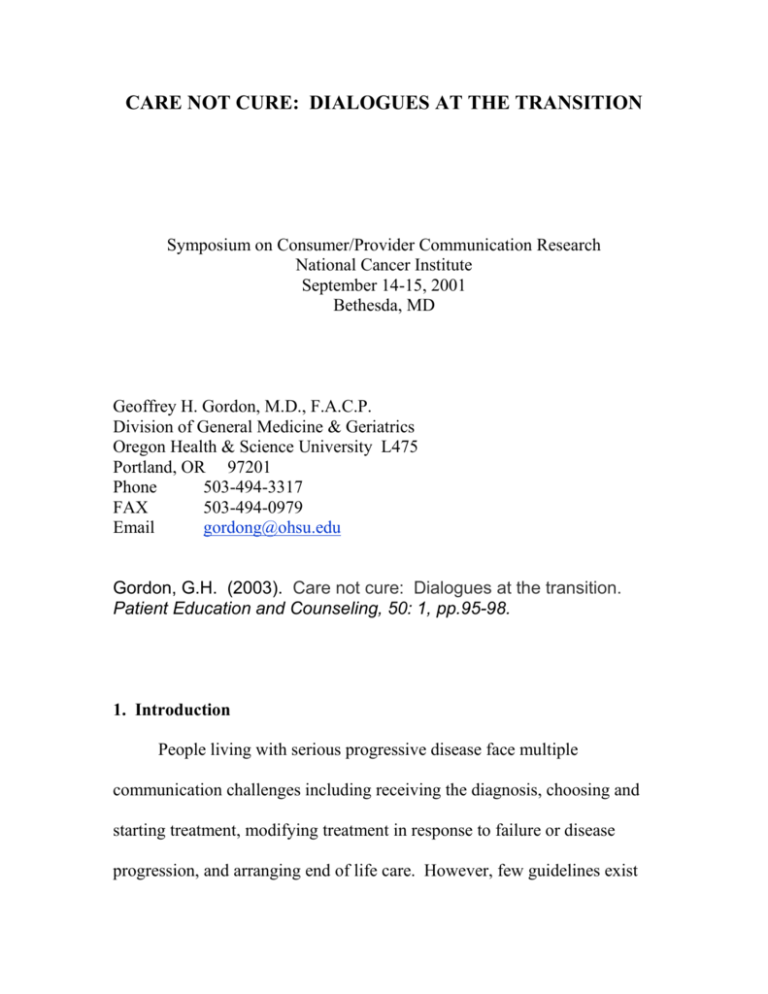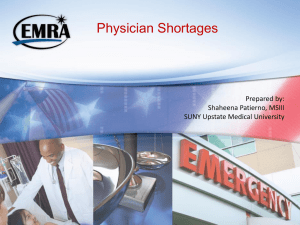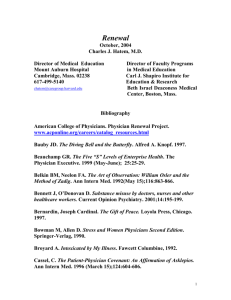Care Not Cure: Dialogues at the Transition
advertisement

CARE NOT CURE: DIALOGUES AT THE TRANSITION Symposium on Consumer/Provider Communication Research National Cancer Institute September 14-15, 2001 Bethesda, MD Geoffrey H. Gordon, M.D., F.A.C.P. Division of General Medicine & Geriatrics Oregon Health & Science University L475 Portland, OR 97201 Phone 503-494-3317 FAX 503-494-0979 Email gordong@ohsu.edu Gordon, G.H. (2003). Care not cure: Dialogues at the transition. Patient Education and Counseling, 50: 1, pp.95-98. 1. Introduction People living with serious progressive disease face multiple communication challenges including receiving the diagnosis, choosing and starting treatment, modifying treatment in response to failure or disease progression, and arranging end of life care. However, few guidelines exist to help clinicians talk with patients and families when the burdens or risks of treatment outweigh the benefits, and the focus of care shifts from prolonging survival to improving quality of life (1,2). This conversation may take place over several encounters until the patient, family, and medical team are all in agreement regarding the goals, methods, and expected results of treatment. The goal of this article is to highlight some challenges to effective communication at transitions to palliative care, review communication skills training for physicians, and raise questions for further research. 2. Communication challenges at the transition Conversations about care when treatment fails to cure or control the disease can be extraordinarily difficult for doctors, patients, and families. Immediate and urgent issues for communication include 1) prognostic uncertainty (“How much time do I have?”), 2) death and dying (“Where and how will I die?”), and 3) the definition of hope (“I can’t lose hope – but what am I hoping for?”). Discussing prognostic uncertainty is problematic because physicians: 1) have trouble estimating when a patient will die (3); 2) give a falsely optimistic prognosis to dying patients (4); and 3) introduce bias when explaining probabilities (5,6). Our culture has made dying a medical problem rather than a natural event, but our current medical education and delivery system is not prepared to handle end of life care (7- 9). Finally, physicians define hope in terms of disease response or improved survival and experience treatment failure as “taking away the patient’s hope.” In fact, patients find new objects and sources of hope as disease progresses, and lose hope when they feel abandoned or isolated (“there is nothing more we can do for you”) or when they suspect their doctors or families are withholding information (10-13). In an ideal transition scenario the physician: 1) asks what the patient understands about the nature and extent of the disease and the goals and results of treatment; 2) allows the patient to express feelings; and 3) asks about specific concerns such as anticipated physical symptoms, loss of function, mood changes, or impact on the family (14,15). The physician explicitly acknowledges that the disease is progressing despite all available and appropriate treatment, and expresses the wish that things were different (16). The physician then reassures the patient that care will continue, with the aim of clarifying and achieving their hopes and goals within the constraints of progressive disease. The physician and medical team shift attention and language away from the disease process and toward relief of suffering and maintaining function (2). Finally, the physician and team might reflect, individually or together, on their reactions to the treatment failure and how it affects their roles and relationships with the patient, family, and each other (17,18). 3. Communication skills training for physicians Communication skills are linked to important outcomes such as greater satisfaction (patient and physician), greater patient understanding and acceptance of treatment plans, reduced patient distress, and fewer lawsuits (19,20). Interventions to improve physician-patient communication improve patient outcomes in hypertension, diabetes, and post-operative recovery (2123). In oncology, benefits of effective communication include improved patient coping, quality of life, and distress, and reduced clinician fatigue, emotional exhaustion, and burnout (24,25). Common communication deficiencies include interrupting patients early in the encounter (26,27), failing to elicit the full range of patient concerns (26,28), missing opportunities to express understanding of the patient’s ideas and feelings (29,30), and minimizing the patient’s role in treatment planning (31,32). However, communication skills can be taught, learned, and maintained for physicians at all levels of training (33-38), including skills for giving bad news (39-41). Workshops for practicing oncologists can improve self-rated communication skills (41) as well as skills with simulated (42) and actual (43) patients. These latter workshops include essential elements of skills-based learning such as 1) a supportive learning climate, 2) negotiated goals with the learner, 3) clear description and demonstration of the desired skills, 4) practice with observation and feedback, 5) periodic review and application of the skills to situations of increasing complexity, and 6) opportunities for personal reflection on one’s experiences as a learner and clinician (43-44). 4. Communication skills at the transition: areas for research 4.1. Teaching 4.1.1 What is the “dose-response” effect for communication skills training? What kind of teaching, for how long, is optimal for improving clinicians’ communication skills? Medical student and resident programs last 2-4 hours; residential workshops for practitioners last 2-3 days. Workshops of several sessions followed by ongoing coaching may be more effective than single training events. We need to know more about the optimal “dose” (amount and frequency) of teaching, the impact of “boosters” to revisit and reinforce learning, and appropriate “responses” or outcome measures for learners at different levels of expertise. 4.1.2. What is the best method of delivering communication skills training? The knowledge base and concepts underlying communication skills can be presented in writing, lecture, or on line. However, communication skills are best learned through practice with direct observation and feedback. Some faculty training may be necessary, since faculty who teach communication vary widely in the issues they identify and teach about (45). 4.1.3. How do you measure success of teaching? Success has many levels including acquiring a skill, using it in practice, and affecting patient outcome. A variety of communication skill assessment instruments are available but only a few have been studied extensively (46). Currently there is no “gold standard” measure that is widely accepted and applicable across a wide spectrum of clinical encounters. Communication skills and impact of training may be best assessed in a 360 degree fashion with ratings by self, patients (real or simulated), and observers (faculty, staff, peers) (47). 4.2. Practice 4.2.1. What is the best way to discuss prognostic uncertainty with patients? Traditionally, physicians view disclosing uncertainty as potentially damaging to the doctor-patient relationship. However, empirical studies refute this (48). Aids to shared decisions in cancer and other areas are available but not widely used (49). Qualitative analysis of comments by individual physicians and patients as they review videotapes of actual decision-making conversations could provide new directions for research. 4.3. Systems 4.3.1. What is the relative importance of system effect versus training effect in changing physician behavior? The SUPPORT study indicated that there is a limit to the effectiveness of physician-patient communication skills training on practice habits in end of life care (7). Determining the relative impact of changes in leadership, policies, resources, and training on the quality of end of life care is an important research area (50). 4.3.2. What are the characteristics of physicians who obtain additional training in communication skills? What are the characteristics of systems that encourage or mandate this training? Physicians who voluntarily enroll in 2-5 day communication skills training programs are usually already aware of the importance of these skills to their work. Some have additional interests in psychosocial medicine, or in experiential, interactive teaching methods. Physicians enrolling in workshops on specific topics (for example, taking a sexual history or giving bad news) want practical tips and updates because they encounter the problem frequently, or find it interesting or difficult. Health care systems that encourage or mandate communication skills training want to maintain high patient satisfaction scores to retain patients in the system and to reduce malpractice risk. 5. Conclusion Medical educators are implementing competency-based assessment and certification of individuals and training programs, including communication and interpersonal skills (73). At the same time, health care organizations increasingly view communication as an essential element of patient safety and quality of care (51). These initiatives will provide new opportunities for collaborative research on patient-centered and systemsbased teaching and practice, including communication around management of cancer and other serious progressive disease (52). REFERENCES [1] The A, Hak T, Loeter G, ven der Wal G. Collusion in doctor-patient communication about imminent death: An ethnographic study. BMJ 2000;321:1376-1381. [2] Norton SA, Bowers BJ. Working toward consensus: Providers’ strategies to shift patients from curative to palliative treatment goals. Res Nurs Health 2001;24:258-269. [3] Finucane TE. How gravely ill becomes dying: a key to end-of-life care. JAMA 1999;282:1670-1672. [4] Lamont EB, Christakis NA. Prognostic disclosure to patients with cancer near the end of life. Ann Intern Med 2001;134:1196-1105. [5] Mazur DJ, Merz JF. Patients’ interpretations of verbal expressions of probability: implications for securing informed consent to medical interventions. Behav Sci Law 1994;12:417-426. [6] O’Connor AM. Effects of framing and level of probability on patients' preferences for cancer chemotherapy. J Clin Epidemiol 1989;42:119-26. [7] The SUPPORT Principal Investigators. A controlled trial to improve care for seriously ill hospitalized patients. The study to understand prognoses and preferences for outcomes and risks of treatments (SUPPORT). JAMA 1995;274:1591-1598. [8] Quill TE, Suchman AL. Uncertainty and control: learning to live with medicine’s limitations. Humane Medicine 1993;9:109-120. [9] Lynn J. Serving patients who may die soon and their families: The role of hospice and other services. JAMA 2001;285:925-932. [10] Lee SJ, Fiarclough D, Antin JH, Weeks JC. Discrepancies between patient and physician estimates for the success of stem cell transplantation. JAMA 2001;285:1034-1038. [11] Herth K. Fostering hope in terminally ill people. J Adv Nurs. 1990;15:1250-1259. [12] Weissman D. Fast Fact #21: Hope and truth telling. End-of-Life Physician Education Resource Center (EPERC), September 2000. www.eperc.mcw.edu. Accessed August 28, 2001. [13] Fallowfield LJ, Jenkins VA, Beveridge HA. Truth may hurt but deceit hurts more: communication in palliative care. Palliat Med 2002;16:297-303. [14] Baile WF, Glober GA, Lenzi R, Beale EA, Kudelka AP. Discussing disease progression and end-of-life decisions. Oncology 1999;13:1021-1035. [15] Lo B, Quill T, Tulsky J. Discussing palliative care with patients. Ann Intern Med 1999;13:744-749. [16] Quill TE, Arnold RM, Platt F. “I wish things were different.” Expressing wishes in response to loss, futility, and unrealistic hopes. Ann Intern Med 2001;135:551-555. [17] Block SD. Perspectives on care at the close of life. Psychological considerations, growth, and transcendence at the end of life: the art of the possible. JAMA 2001;285:2898-905. [18] Meier DE, Back AL, Morrison RS. The inner life of physicians and care of the seriously ill. JAMA 2001;286:3007-3014. [19] Hall JA, Roter DL, Katz NR. Meta-analysis of correlates of provider behavior in medical encounters. Med Care 1988;26:657-675. [20] Stewart M, Brown JB, Boon H, Galajda J, Meredith L, Sangster M. Evidence on doctor-patient communication. Cancer Prev Control. 1999;3:25-30. [21] Kaplan SH, Greenfield S, Ware JE JR. Assessing the effects of physician-patient interactions on the outcomes of chronic disease. Med Care 1989;27:S110-127. [22] Rost KM, Flavin KS, Cole K, McGill JB. Change in metabolic control and function status after hospitalization. Impact of patient activation intervention in diabetic patients. Diabetes Care 1991;14:881-889. [23] Gittell JH, Fairfield KM, Bierbaum B, et al. Impact of relational coordination on quality of care, postoperative pain and functioning, and length of stay: a nine-hospital study of surgical patients. Med Care 2000;38:807-819. [24] Fallowfield LJ, Hall A, Maguire GP, Baum L. Psychological outcomes of different treatment policies in women with early breast cancer outside a clinical trial. BMJ 1990;301:575-580. [25] Maguire P. Improving communication with cancer patients. Eur J Cancer 1999;35:1415-1422. [26] Beckman HB, Frankel RM. The effect of physician behavior on the collection of data. Ann Intern Med 1984;101:692-696. [27] Maguire P, Faulkner A, Booth K, Elliott C, Hillier V. Helping cancer patients disclose their concerns. Eur J Cancer 1996;32A:78-81. [28] Stewart MA, McWhinney IR, Buck CW. The doctor / patient relationship and its effect upon outcome. J R Coll Gen Pract 1979;29:77-82. [29] Eisenthal S, Koopman C, Stoeckle JD. The nature of patients’ requests for physicians’ help. Acad Med 1990;65:401-405. [30] Suchman AL, Markakis K, Beckman HB, Frankel R. A model of empathic communication in the medical interview. JAMA 1997;277:678-682. [31] Waitzkin H. Doctor-patient communication. Clinical implications of social scientific research. JAMA 1984;252:2441-2446. [32] Gaudagnoli E, Ward P. Patient participation in decision-making. Soc Sci Med. 1998;47:329-39. [33] Maguire P. Can communication skills be taught? Br J Hosp Med 1990;43:215-216. [34] Roter DL, Hall JA, Kern DE, et al. Improving physicians’ interviewing skills and reducing patients’ emotional distress. A randomized clinical trial. Arch Intern Med 1995;155:1877-1884. [35] Putnam SM, Stiles WB, Jacob MC, James SA. Teaching the medical interview: an intervention study. J Gen Intern Med 1988;3:38-47. [36] Bowman FM, Goldberg DP, Millar T. Improving the skills of established general practitioners: the long-term benefits of group teaching. Med Educ 1992;26:63-68. [37] Maguire P, Fairbairn S, Fletcher C. Consultation skills of young doctors: I- Benefits of feedback training inter interviewing as students persist. Br Med J 1986;292:1573-1576. [38] Stillman PL, Sabars DL,. Redfield DL. The use of para-professionals to teaching interviewing skills. Pediatrics 1976;57:769-774. [39] Vetto JT, Elder NC, Toffler WL, Fields SA. Teaching medical students to give bad news: does formal instruction help? J Cancer Educ 1999;14:13-17. [40] Jewett LS, Greenberg LW, Champion LA, Gluck RS, Leikin SL, Altieri MF, Lipnick RN. The teaching of crisis counseling to pediatric residents: a one-year study. Pediatrics 1982;70:907-911. [41] Baile WF, Kudelka AP, Beale EA, Glober GA, Myers EG, Greisinger AJ, Bast RC Jr, Goldstein JB, Novack D, Lenzi R. Communication skills training in oncology. Description and preliminary outcomes of workshops on breaking bad news and managing patient reactions to illness. Cancer 1999;86:887-897. [42] Maguire P, Booth K, Elliott C, Jones B. Helping health professionals involved in cancer care acquire key interviewing skills – the impact of workshops. Eur J Cancer 1996;32A:1486-1489. [43] Fallowfield L, Jenkins V, Farewell V, Saul J, Duffy A, Eves R. Efficacy of a Cancer Research UK communication skills training model of oncologists: A randomized controlled trial. Lancet 2002;359:650-656. [44] Kurtz S, Silverman J, Draper J. The ‘how’: principles of how to teach and learn communication skills. In: Kurtz S, Silverman J, Draper J. Teaching and learning communication skills in medicine. Abdingdon, Oxon: Radcliffe Medical Press. 1998;33-50. [45] Buyck D, Lang F. Teaching medical communication skills: a call for greater uniformity. Fam Med 2002;34:337-343. [46] Boon H, Stewart M. Patient-physician communication assessment instruments: 1986 to 1996 in review. Patient Educ Couns 1998;35:161-176. [47] Accreditation Council for Graduate Medical Education. Outcomes project: Enhancing residency education through outcomes assessment. Available at http://www.acgme.org/outcome/comp/compFull.asp. Accessed May 7, 2002. [48] Gordon GH, Joos SK, Byrne J. Physician expressions of uncertainty during patient encounters. Patient Educ Couns 2000;40:59-65. [49] O’Connor AM, Stacey D, Rovner D, Holmes-Rovner M, Tetroe J, Llewellyn-Thoomas H, Entwistle V, Rostom A, Fiset V, Barry M, Jones J. Decision aids for people facing health treatment or screening decisions. Cochrane Database Syst Rev. 2001;(3):CD001431. [50] Lynn J, DeVries KO, Arkes HR, Stevens M, Cohn F, Murphy P, Cinvinsky KE, Hamel MB, Dawson NY, Tsevat J. Ineffectiveness of the SUPPORT intervention: review of explanations. J Am Geriatr Soc 2000;48:S206-213. [51] Berwick DM. A user's manual for the IOM's 'Quality Chasm' report. Health Aff (Millwood) 2002;21:80-90. [52] Weissman DE, Block SD, Blank L, Cain J, Cassem N, Danoff D, Foley K, Meier D, Schyve P, Theige D, Wheeler HB. Recommendations for incorporating palliative care education into the acute care hospital setting. Acad Med 1999;74:871-877.









